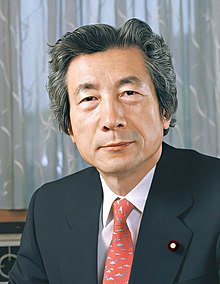

Prime Minister of Japan
January 8, 1942 Yokosuka, Kanagawa Prefecture, Empire of Japan
-
April 26, 2001 – September 26, 2006
Prime Minister of Japan from 2001-06 The native form of this personal name is Koizumi Jun'ichirō. This article uses Western name order when mentioning individuals. Junichirō Koizumi小泉 純一郎 Prime Minister of JapanIn office April 26, 2001 – September 26, 2006MonarchAkihitoPreceded by Yoshirō MoriSucceeded by Shinzo AbePresident of the Liberal Democratic PartyIn office April 20, 2001 – September 26, 2006Preceded by Yoshirō MoriSucceeded by Shinzo AbeMinister of Health and WelfareIn office November 7, 1996 – July 29, 1998Prime Minister Ryutaro HashimotoPreceded by Naoto KanSucceeded by Sohei MiyashitaIn office December 27, 1988 – August 10, 1989Prime Minister Noboru Takeshita Sōsuke Uno Preceded by Takao FujimotoSucceeded by Saburo ToidaMinister of Post and TelecommunicationsIn office December 12, 1992 – July 20, 1993Prime Minister Kiichi MiyazawaPreceded by Hideo WatanabeSucceeded by Kiichi MiyazawaMember of the House of Representatives for Kanagawa 11th districtIn office December 10, 1972 – August 30, 2009Preceded by New constituencySucceeded by Shinjirō Koizumi Personal detailsBorn (1942-01-08 ) January 8, 1942 (age 79) Yokosuka, Kanagawa Prefecture, Empire of JapanPolitical partyLiberal Democratic PartySpouse(s)Kayoko Miyamoto (m. 1978; div. 1982)Children Kōtarō Koizumi Shinjirō Koizumi Yoshinaga Miyamoto Alma mater Keio University (BEc) University College London Junichiro Koizumi (/k ɔɪ ˈ z uː m i / ; 小泉 純一郎 , Koizumi Jun'ichirō ; born January 8, 1942) is a Japanese politician who was Prime Minister of Japan and President of the Liberal Democratic Party (LDP) from 2001 to 2006. He retired from politics in 2009, and he remains the sixth-longest serving Prime Minister in Japanese history. Widely seen as a maverick leader of the LDP upon his election to the position in 2001, he became known as a neoliberal economic reformer, focusing on reducing Japan's government debt and the privatisation of its postal service. In the 2005 election, Koizumi led the LDP to win one of the largest parliamentary majorities in modern Japanese history. Koizumi also attracted international attention through his deployment of the Japan Self-Defense Forces to Iraq, and through his visits to the Yasukuni Shrine that fueled diplomatic tensions with neighbouring China and South Korea. Koizumi resigned as Prime Minister in 2006. Although Koizumi maintained a low profile for several years after he left office, he returned to national attention in 2013 as an advocate for abandoning nuclear power in Japan, in the wake of the 2011 Fukushima nuclear disaster, which contrasted with the pro-nuclear views espoused by the LDP governments both during and after Koizumi's term in office.

We use cookies
We use cookies and other tracking technologies to improve your browsing experience on our website, to show you personalized content and targeted ads, to analyze our website traffic, and to understand where our visitors are coming from. Privacy Policy.